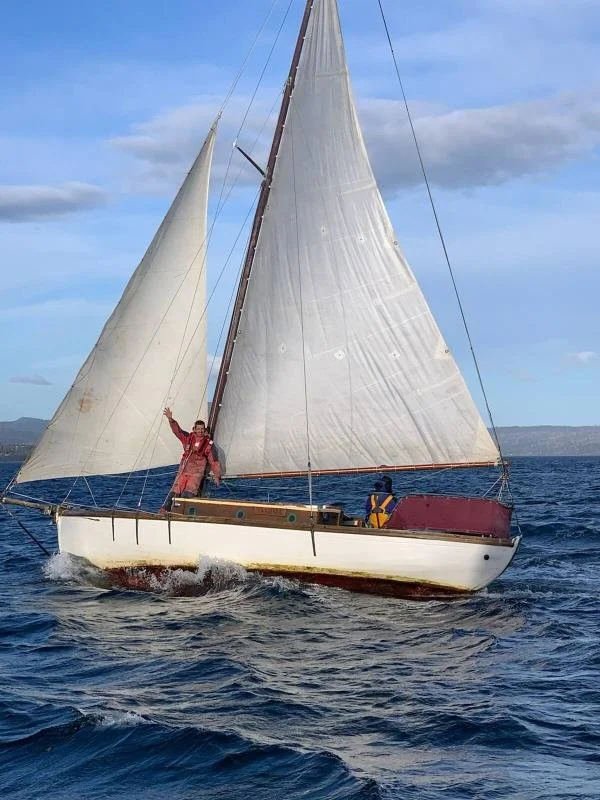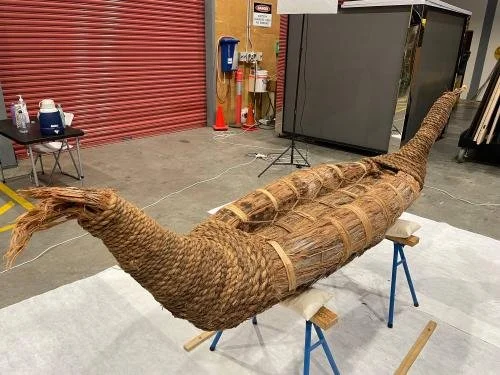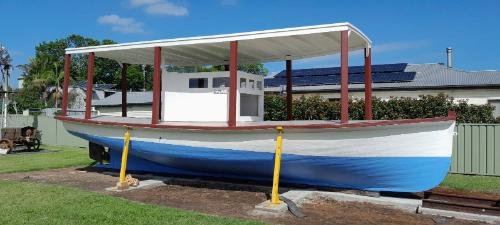Story Telling at its best
Back in early August we wrote a piece about the Australian National Maritime Museum’s Register of Historic vessels. Well this week we received an email from them notifying SWS that a a dozen new boats has been accepted onto the Register. The boats are great, but the stories they tell are exceptional! Here’s a quick summary…
TAMIMA
Tamima was designed as a 30ft cruiser by W D Bailey in the Southern Sydney suburb of Como in 1929. It was then built in Bellerive Tasmania by Dave O’May and launched in late 1930. It is a canoe sterned yacht slightly larger than Bailey’s 27ft transom sterned Albatross he designed in 1927. ‘Tamima’ translates to Albatross in the language of the Bruny Island community. Following its design, the lines of Tamima were published in Australian Motor Boat and Yachting in 1929.
Dave O’May (1908-1976) was trained as carpenter, a skill required within the family ferry business, and built Tamima while still very young. He built the much larger replacement Moorina in the late 1950s. He also built two Tamar dinghies in 1951, #8 TARINNA, and #25 SWIFT). From late 1930s to his retirement he was manager of the Derwent ferry fleet for Hobart Bridge Company and later the Tasmanian Transport commission, and no doubt did not have much time for boatbuilding. READ MORE HERE
STREETER
Streeter was built in 1960 in Broome for use as a pearling lugger. It was designed by Alf Morgan, built by Arthur Male and named after Edwin Williams Streeter, considered by many the ‘father’ of Broome’s pearling industry. Streeter II was part of the famous Streeter & Male Pearl Fleet. In 1978 Streeter was relocated to Darwin to fish for barramundi and mackerel and since 2006 has operated as a tourist vessel offering cruises on Darwin Harbour.
Streeter is 55ft overall in length and 14 ft 7 inches across its beam. Its hull was built to standard Broome lugger form following World War Two, likely using moulds shared amongst a number of craft. It is carvel planked with a heavy sheer strake and has the classic shallow, moderate deadrise hull shape used to suit drying-out on the low tides at Broome. It has an overhanging counter stern and spoon bow, the hull originally constructed of jarrah, and since replaced partially with spotted gum. A 6 cylinder 1974 Gardener diesel engine is fitted. READ MORE HERE
Blue Nemo
The Blue Nemo (Latin for ‘no-one’) Uncrewed Surface Vessel (USV) was developed by Australian solar sailor company Ocius. The USV’s design began in 2007 when Ocius received an enquiry from an interest body in the USA for a platform that could ‘go to sea forever’. Ocius subsequently began the process of developing the design for an uncrewed surface vessel. This involved the building of five scale models for tank and lake testing, culminating in the building of the 10ft prototype Blue Nemo. Each of these models were fixed with a horizontal rudder ‘flipper’ fixed along differing sections of the underside of the model and tested out in a wave tank for speed to reach a set distance. The model with a sole front flipper attached performed the best, and the Blue Nemo was subsequently fitted with one front flipper. READ MORE HERE
RAAF 011-118
RAAF 011-118 is a workboat that was built for the RAAF in 1945. It was built by Slazenger and issued to the RAAF in September 1945 indicating that it did not see war service. 011-118 was one of 120 02 class workboats manufactured for the RAAF. It was struck off charge and declared for disposal in 1954 (information provided by David Gardiner Senior Air force curator RAAF Base Point Cook). It is 22.5ft (6.7m) in length and has a large cockpit with narrow side decks, a foredeck, a short aft deck, and a planing hull. It was of chine plywood construction, and had a towing post abaft the engine casing. It is similar to RAAF 011-29 (HV000427) a carvel planked launch that supported the Catalina and Sunderland flying boats that patrolled looking for Japanese submarines off the NSW coastline.
These vessels were built as part of a massive war effort around the country which saw commercial and pleasure craft builders employed to build small to medium sized workboats and launches. These craft acted as support vessels for enclosed water duties all around Australia and further north where action took place. A series of the RAAF 011 boats were built by Slazenger, such as RAAF 011-118, the company operating workshops in Sydney and Newcastle. The boats were built in batches with consecutive numbers. READ MORE HERE
LIZARD
Lizard is a 17ft net fishing boat designed and built c. 1980 by Neil Drake in Triabunna on the east coast of Tasmania. It was used for seine netting Australian salmon from beaches in the south east of Tasmania, the fish then processed in Triabunna for both human consumption and cray bait. Lizard is now on display at the Spring Bay Marine Discovery Centre in Triabunna. Lizard is a carvel planked dinghy and built lightly for launching at the beach and rowing. Its hull is constructed of local King Billy pine with copper, silicone and bronze fastenings. It has a transom mounted roller to allow net setting with ease. READ MORE HERE
Ningher canoe
Ningher canoes are the unique traditional watercraft of Tasmanian Palawa, Aboriginal, community. In 2007 the practice of constructing these canoes was revived for the first time in almost two hundred years by Brendon (Buck) Brown, Tony Burgess, Sheldon Thomas and Shayne Hughes. This group constructed a 17ft Tuylini stringybark canoe for display in the Ningina Tunapri exhibition at the Tasmanian Museum and Art Gallery (TMAG). This canoe is now on permanent display at TMAG. A second canoe built from this period was successfully launched in the sheltered waters of Cornelian Bay on the River Derwent.
Ningher’s are constructed of locally sourced material, including juncus reed to provide buoyancy and bindings that lash the canoe together made of swamp grass. Materials used in construction vary dependent on the region, stringy-bark common in the south; paper-bark in the north-west; and reeds in the east. Naming terminology for the canoes follows the material type, ‘Ningher’ generally denoting paperbark and ‘Tuylini’ stringybark. The approach to construction is the same. Three to five bundles of bark or reed are lashed together with fibre cord and tapered at the ends so that the bow and stern rise high out of the water. Fire can be carried on a bed of clay and the canoe propelled by a pole, or by a person swimming alongside. READ MORE HERE
Tuylini Canoe
This canoe at the ANMM is a stringybark Tuylini canoe made by Sheldon Thomas, originally from the Bunurong community in south eastern Victoria. Thomas constructed this Tuylini in Southport Tasmania in 2022. It was made for use in the ANMM exhibition Shaped By the Sea and is now also part of the National Maritime Collection. READ MORE HERE
Mavis Pearl
Mavis Pearl is a 14ft cray fish dinghy designed and built by Noel Wilson and Ron Helm in Georgetown Tasmania in 1958. Mavis Pearl’s carvel hull is built of local King Billy pine and it has a tumblehome transom 4.5ft across at its widest point. This wide beam allowed for maximum storage of up to six cray pots. As first owners, Noel and Ron holidayed in Triabunna for many years using Mavis Pearl as their Cray boat. It is now on display at the Spring Bay Maritime & Discovery Centre.
Cray or Pot dinghies of this kind were used in Tasman waters as part of the cray fish industry from 1915 to c. 1970. Professional fisherman used these dinghies inshore off larger boats, where as amateurs used them offshore. In 1925 a newly appointed Sea Fisheries Board legalised the use of craypots and implemented other regulations including limiting the number of pots on a vessel, introducing minimum legal lengths and prohibiting the capture and sale of soft shell juvenile lobsters. The legalization of pots led to an increase in commercial catch and efficiency, the southern rock lobster industry generally resilient during World War One, Two, and the Great Depression. Between 1956 and 1972 there was a particular boom with the number of pots used in Tasmania increasing by 7000. READ MORE HERE
Sunlight
Sunlight was built in 1933 by the William Ryan Shipyard in Taree. It was launched on the nineth of December 1933 from the slipway at Mitchells Island by the Manning River Dairy Cooperative. For thirty six years until 1969 Sunlight operated as a milk and cream boat on the Manning River under the Lower Manning Dairy Cooperative. 29ft in length, Sunlight was specifically designed for the narrow and shallow reaches of the lower Manning River in the Ghinni Ghinni creek area, regions larger vessels had difficulty navigating. As of 2023 Sunlight is displayed on the grounds of Cundletown and Lower Manning Historical Society. READ MORE HERE
Wampoo
It is believed that Wampoo was built in 1954 by the Settree family in Huskisson NSW, its hull constructed from either NZ Kauri or spotted gum with a battened seam carvel construction. It is an open small wooden fishing boat, 15ft in length, with an original rudder, tiller, and engine. The motor is a two cylinder Clae petrol side valve Model F10, built by Clae Engine Pty Ltd in Bankstown. Wampoo’s deck is made with marine ply, and it is a flat-bottomed vessel.
Settree Boat builders in Huskisson have an extensive history of providing fishing trawlers for commercial fishing, but they also built smaller recreational fishing boats for locals such as Wampoo. This boat captures the historical and social context of the local village and recreational fishing from the 1950s to the 1970s. It was used entirely in Jervis Bay until it was sold to the current owners. READ MORE HERE
M.V Nokomis
M.V Nokomis is a 40-foot timber river launch that was built and launched in Perth in 1923. It was commissioned by a prominent businessman, W.J. Winterbottom, then Commodore of the Royal Perth Yacht Club. M.V Nokomis was designed by John Easton and built at the W&S Lawrence and Sons shipyard located on Barrack Street. It was planned as a recreational English river motor yacht modelled on boat designs common during the late 1910’s and early 1920’s. “Nokomis” and Indigenous word derived from the Ojibwe nation in North America. It is the name of an important figure in the traditional stories of the Ojibwe. READ MORE HERE
Berrimilla II
Berrimilla II was built in Mona Vale Sydney in 1977 as an ocean cruising and racing yacht, then under the name of Nea. It was designed by Peter Joubert as a Brolga 33ft masthead sloop, with a Glass Reinforced Plastic (GRP) hull, deep fin keel, fully encapsulated lead ballast and skeg hung rudder. Berrimilla II's cabin and superstructure are also constructed of fiberglass, its deck a mixture of wood and fiberglass. Joubert was a highly respected designer of extremely tough and seaworthy yachts, Berrimilla II a prime example with its displacement hull style. This heavier construction meant it would be a slower yacht to sail, but more than capable of sailing through the toughest conditions with the right preparation and crew. As an example, Berrimilla’s stability index is 141.6 and the vessels’ calculated limit of positive stability is 135.4 degrees – a reassuring trait in large swells.
More than a hundred yachts have been built to Joubert’s designs, many of which have seen successes in the Sydney to Hobart Yacht Race. Zeus II, a Currawong 31 was one such yacht, the overall winner of the 1981 Sydney to Hobart, Berrimilla II also a winner during the highly dangerous 1998 race claiming first in the PHS category. Berrimilla II may be one of his most successful through its extraordinary feats of achievement from 2004-2010 in voyaging and racing. Over this period, owner and skipper Alex Whitworth sailed double handed twice around the world. READ MORE HERE












